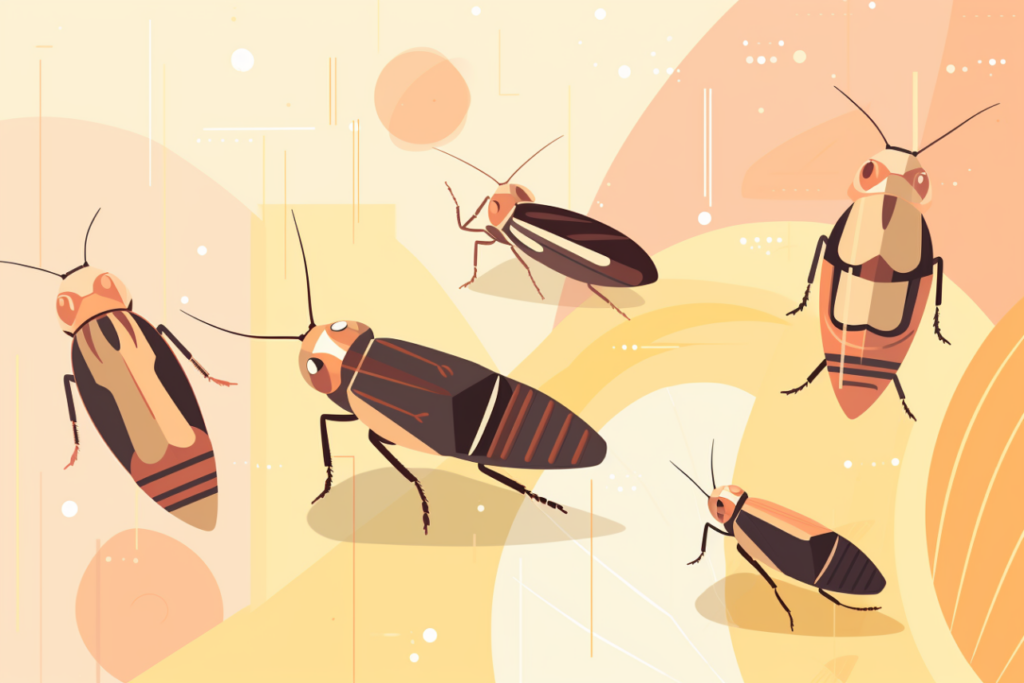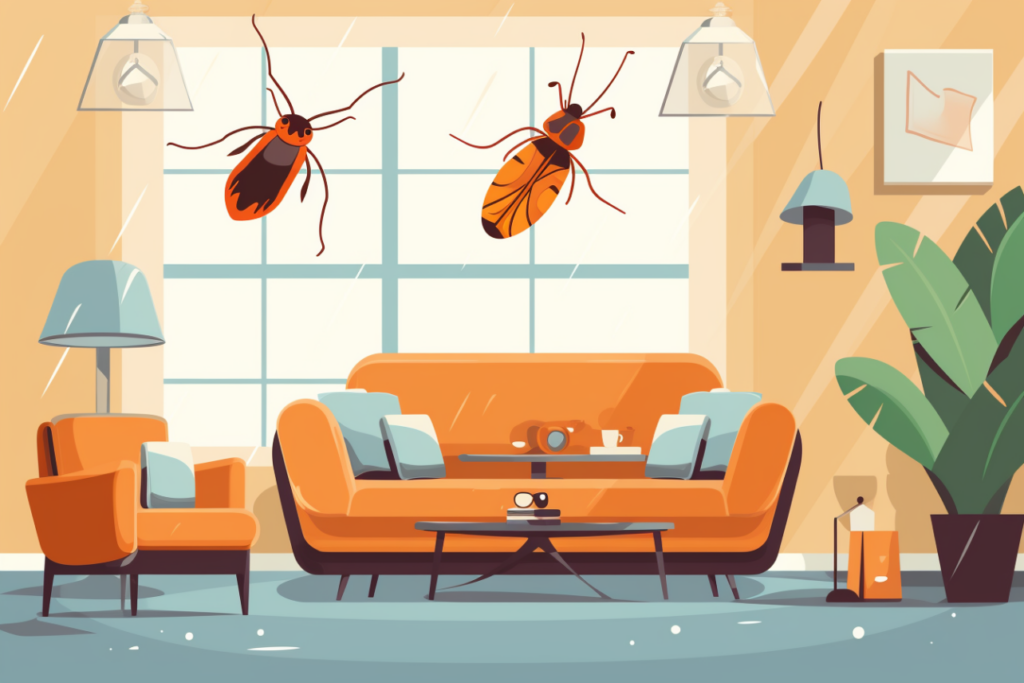Scientifically known as hemipterans, water bugs are aquatic insects often confused with cockroaches, beetles, or even spiders. While water bugs are intriguing creatures that play an essential role in their ecosystems, we’ll shed light on their unique characteristics and help readers identify them correctly.
Let’s dive into the fascinating world of water bugs!
Water Bug Species Descriptions
There are a few different types of water bugs, and we will explain them a little more below to help you identify which type of pest you are dealing with.
Giant Water Bugs (Belostomatidae)
Giant water bugs are the largest specimens within the water bug family, with actually over 500 different species. They can grow up to 4 inches (10 cm) long and have a distinctive flat and oval-shaped body. With piercing mouthparts resembling a rostrum, these bugs are voracious predators.
They feed on small aquatic creatures and even small vertebrates in ponds, lakes, and slow-moving streams. Giant water bugs are easy to recognize by their dark brown or black exoskeletons and flattened hind legs, which are excellent for swimming. They have shorter antennae and are a tad flatter in the body than other bugs.
Water Boatmen (Corixidae)
Unlike giant water bugs, water boatmen are smaller and less intimidating in appearance. Ranging from 3 to 13 mm long, boatmen have an elongated, torpedo-shaped body that allows them to swim rapidly.
They possess long, oar-like hind legs perfect for rowing through water. Boatmen are easily identified by their brownish bodies, paddle-like appendages, and prominent eyes. They are often observed in freshwater bodies, where they feed on algae, detritus, and occasionally small invertebrates. Their antennae are not visible from above like other types of water bugs.
Backswimmers (Notonectidae)
Backswimmers are another common type of water bug. As the name suggests, they swim on their backs, propelling themselves by rowing their powerful hind legs. Their streamlined, oval-shaped bodies are usually dark brown or black and exhibit an adaptation allowing them to float upside-down at the water’s surface.
Backswimmers possess a long beak-like mouthpart that extends forward when hunting prey, such as mosquito larvae, small crustaceans, and even tadpoles. They tend to dwell in freshwater ponds, slow streams, and marshes.
How To Get Rid Of Water Bugs

While they might startle you when spotted in your kitchen or bathroom, the good news is that you can rid your home of these unwelcome guests with a few proactive measures.
Here are the seven steps to tackle a water bug issue in your home.
Understand the Enemy
Before diving into elimination tactics, knowing what you’re dealing with is crucial. True water bugs are aquatic insects found predominantly in freshwater habitats. They don’t typically infest homes in large numbers.
However, certain cockroaches are colloquially referred to as “water bugs” and can be a real nuisance if they decide to set up camp in your home.
Eliminate Water Sources
Water bugs thrive in damp conditions. The first step in discouraging their presence is to eliminate any standing water:
- Fix leaky taps and pipes.
- Ensure that your home has good drainage.
- Empty and clean pet water bowls daily.
- Address any dampness issues, like those in basements or crawl spaces, with dehumidifiers.
Clean Thoroughly
Maintaining a clean living environment can deter most pests, including water bugs.
- Wipe down kitchen counters nightly to get rid of crumbs or spills.
- Store food in sealed containers.
- Take out the trash regularly and ensure bins have tight-fitting lids.
- Vacuum frequently, paying attention to hidden spots where crumbs might gather.
Seal Entry Points
Prevent water bugs from entering your home in the first place:
- Inspect your home’s foundation, walls, and windows for cracks and gaps. Seal them with caulk.
- Ensure door sweeps are in good condition.
- Check screens for holes and repair them as needed.
- Cover vents and openings with fine mesh.
Natural Repellents
If you want to go a more natural route, that is an option too. Some natural substances that can deter water bugs are:
Diatomaceous earth: A natural insect killer, sprinkle this around suspected entry points.
Essential oils: A mix of peppermint or eucalyptus oil with water can be sprayed around your home as a natural repellent.
Baits and Insecticides
If you have a severe infestation, use gel baits designed for cockroaches. Water bugs will consume the bait, which acts as a poison.
Consider insecticidal sprays, but ensure they’re safe for indoor use.
With any pesticide, always follow the manufacturer’s guidelines.
Consult a Professional
If you’ve tried the above methods and still find water bugs in your home, it might be time to call the experts. A professional pest control service will identify the specific issue and recommend a tailored approach.
FAQs About Water Bugs
Water bugs are a common concern in many homes, especially those near bodies of water or with damp and humid environments.
Here are some frequently asked questions (FAQs) about water bugs:
Are water bugs the same as cockroaches?
While the term “water bug” is often used interchangeably with cockroaches in some regions, they are different. Cockroaches are pests that can infest homes, while true water bugs are typically found in freshwater habitats.
What attracts water bugs to my home?
Leaky faucets, pipes, or standing water can attract them. They are also drawn to food residue or crumbs.
Are water bugs harmful?
Most water bugs are not harmful to humans and are not known to transmit diseases like some cockroaches. However, the bite of a true giant water bug can be painful.
Do water bugs fly?
Many species of water bugs have wings and can fly.
Where do water bugs lay their eggs?
True water bugs lay their eggs near or on the water source, often attaching them to underwater vegetation. Cockroaches lay egg capsules (oothecae) in hidden locations within homes or buildings.
What do water bugs eat?
True water bugs are predators and will eat small aquatic animals. Cockroaches, on the other hand, are scavengers and will consume a variety of organic materials, from food crumbs to decaying matter.
Can water bugs swim?
True water bugs are excellent swimmers and adapted to aquatic environments. While not aquatic, cockroaches can move through water but are not adapted to swimming.
Do water bugs infest homes in large numbers?
While true water bugs generally don’t infest homes in large numbers, cockroaches can and often do if conditions are favorable.
Water bugs might be unwelcome visitors, but you can reclaim your home with a few preventive and corrective steps.
Remember, the key lies in creating an environment that’s inhospitable to them. With consistency and a bit of effort, you can ensure your living space remains bug-free.
You might also be interested in: How To Get Rid Of Sugar Ants [5 Natural Remedies]




